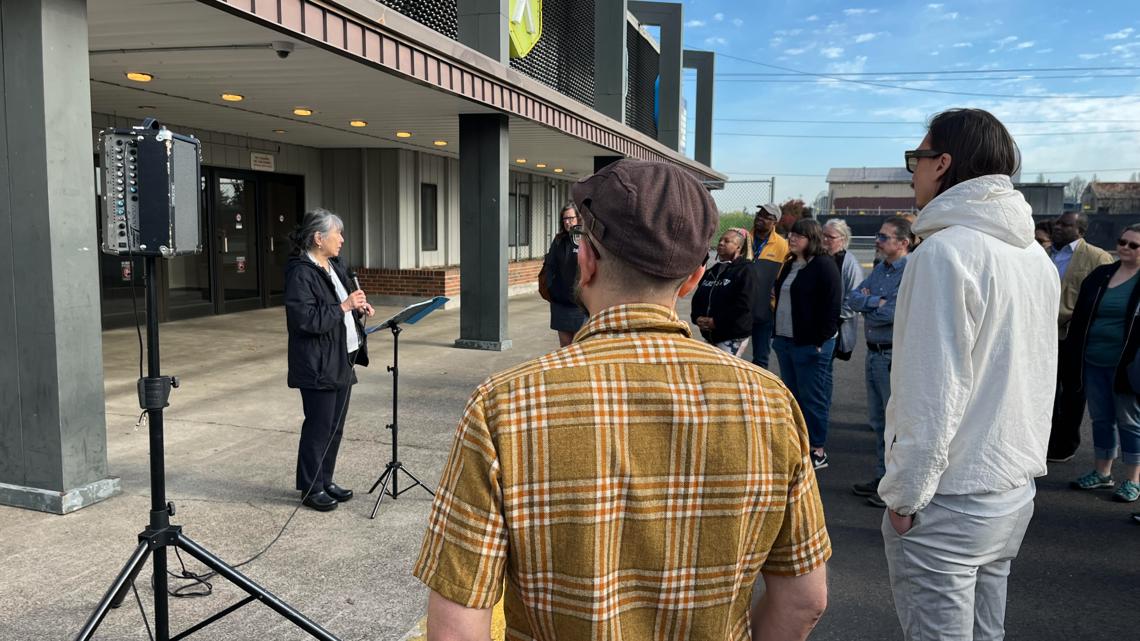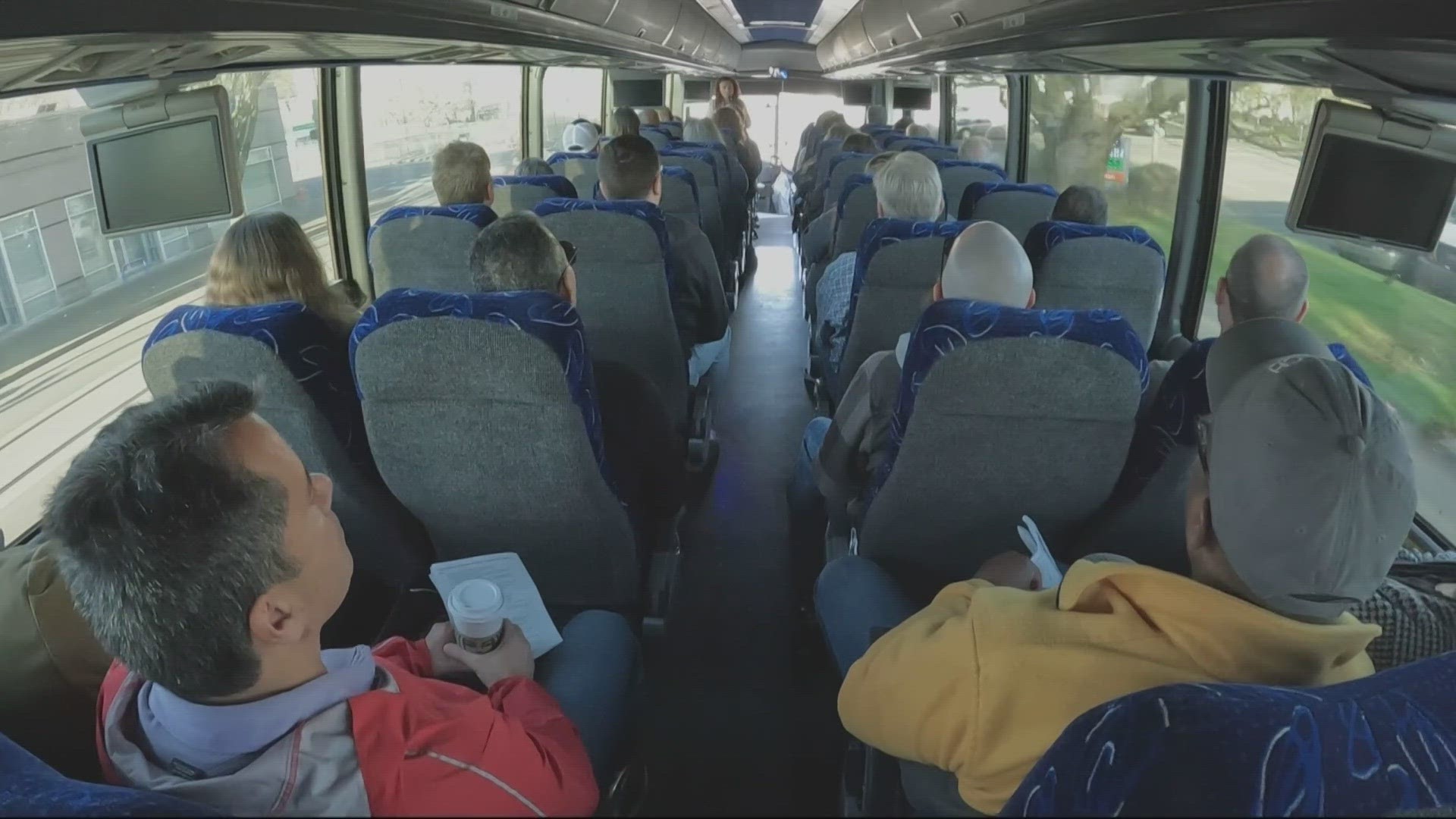PORTLAND, Oregon — A popular bus tour of Portland just started its 16th year, but it's not really geared for tourists. The tour — "Fasten Your Seat Belts ... It's Been a Bumpy Ride" — highlights the history of housing discrimination, presented by the Fair Housing Council of Oregon.
Meeting up for a 4-hour bus tour began at 7:30 a.m. for an 8 a.m. departure. It's the first tour of the season, appropriately starting up during Fair Housing Month.
The group boarding the bus is from Reach Community Development, a nonprofit dedicated to creating stable, affordable housing. Even for those well versed on the subject, there is a lot to take in when it comes to Oregon’s history of housing discrimination, segregation and displacement.
“We often get asked, 'Is housing discrimination still a problem?' And the answer is 'Yes, of course it is, although it may look different than it did 50 years ago,'” said tour guide Shyle Ruder, Fair Housing Council of Oregon's education and outreach director.
We drove by the bronze statue of Dr. Martin Luther King Jr. at the Portland Convention Center, with King standing with an immigrant, a worker and a child.
Our first stop was in the historic Albina District, where Black families were pushed to reside in the early 1900s. Racist policies and practices kept Black Portlanders from living in other "white" neighborhoods for decades, so they developed a strong community here.
It grew as Black Americans from across the country, especially the South, moved here during and after the shipbuilding years of World War II, pushing the Black population from a couple thousand to more than 20,000.
From the 1950s to the 1970s, Albina was torn apart by huge public projects, from freeway building to an expansion plan by Emanuel hospital that cleared homes and businesses — but never happened.
“So, African American families and people lost their homes and businesses due to this proposed expansion and moved north, so there's a real loss of community that happened, as businesses and gathering places were lost,” explained Ruder to the 50 or so people on the tour bus.
Those vacant blocks remain a difficult reminder, but now, thanks to local activism, there is hope for new life here, with lower Albina’s history and inclusion in mind.
Next, our tour took us north, to where Vanport used to be. It was a 650-acre area of West Delta Park, which today includes Heron Lakes Golf Course, where we parked.
We heard from Ed Washington, who moved here as a child.
“My family's from Birmingham, and my dad came out here in 1942 to work in the shipyards with the idea that the family would follow, which we did in 1944,” said Washington.
At its height, Vanport’s population was about 42,000 people, both Black and white, and was the second biggest city in the state. People lived in hastily built apartment homes to accommodate a mass of workers coming to toil in the wartime shipyards of Henry J. Kaiser.
“It was the only public housing project in the country that had a public library,” said Washington.
Washington, now in his 80s, went on to be a civil rights activist and Metro's first black councilor. He currently works part time at Portland State University in the Office of Global Diversity and Inclusion.
He told the tour group that as a kid, despite experiencing instances of racism, Vanport was a good place to live, saying the housing was mostly segregated — but not the community or the schools, where students Black and white learned together.
“You know, growing up here, I always expected that I would become an old man in Vanport — at least that's what I thought back in those days. But that was not destined to happen,” said Washington.
Just six years later, in 1948, a dike gave way. Vanport, built in a Columbia River flood plain, was ruined. It was huge loss for the 17,000 still living there.
“Because this was all we had ... all we had and we never came back. Within 30 to 40 minutes, Vanport was completely underwater,” said Washington.
With a half hour warning, most escaped, but 15 residents died in the flood.
Washington's family had to start over, eventually settling in Northeast Portland. But finding new housing was much harder for Black families from Vanport due to ongoing housing discrimination.
We didn't have to travel far to our next stop, the Portland Expo Center. In the 1940s, it was a livestock exposition facility called the Portland Assembly Center. It served as a temporary internment center for nearly 3,700 Japanese and Japanese Americans during World War II. Most were eventually moved to other internment camps in the West.
“My dad at the time was 16, and he was a sophomore at Lincoln High School,” recalled Marleen Wallingford. Wallingford is a third-generation Japanese American, who told of prison-like conditions for members of Oregon’s Japanese communities.


For many of Japanese heritage, their internment also meant the loss of property and businesses, including farms, they'd worked hard to establish.
“Mothers came into the space and sat down and cried. It was hot and stuffy, and obviously when you have a livestock pavilion, it attracted a lot of flies,” explained Wallingford.
She worked in Portland Public Schools' special education department for nearly 30 years and serves as president of the Portland Japanese American Citizens’ League. Her stories explained how Asian communities, mostly Chinese and Japanese, faced much of the same historic housing discrimination as Black Portlanders.
There was more to the tour than we can describe here, so we will end with what feels like a positive: An improved way of life in the Portsmouth neighborhood, where in 2003, the troubled Columbia Villa public housing was rebuilt and transformed into a new mixed-income neighborhood called New Columbia.
“New Columbia is a diverse community, and there are 22 countries of origin represented, at least 17 different languages,” said Ruder, as the bus navigated the neighborhood streets lined with homes, apartments, community gardens and parks.
At noon, we were back where we started, completing the powerful presentation. The tour stirred feelings in tour-goer Victoria West, who said society needs more change for the better.
“These are issues and things that we continue to deal with ... my feelings around it, it's painful," said West. "I think it takes courage to do this work; any time you're talking about fair housing or equity and inclusion, that's not easy work to do, I commend all the folks who spoke, I thank them.”
For more information about Fair Housing Council of Oregon group tours, visit their website or call (503) 223-8197, ext. 104.

